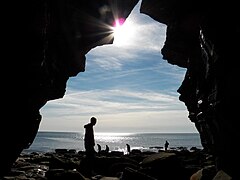St Bees Head
Coordinates: 54 ° 30 ′ 29.5 " N , 3 ° 37 ′ 59.6" W.
St Bees Head is a headland on the coast of Cumbria and is named after the nearby village of St Bees named.
St Bees Head is on the Cumbria Coastal Way and the Coast to Coast walking route. It is the only stretch of coastline between the Welsh and Scottish borders recognized as a Heritage Coast . It is a specially protected nature reserve that has been classified as a Site of Special Scientific Interest (SSSI). Both long-distance hiking trails follow the cliffs that rise around 60 meters from the sea and offer impressive views of the mountains and coast of Cumbria.
North Head
The geographically correct tip is the North Head, which is the most westerly point in northern England . Here is the lighthouse of the St Bees Lighthouse . A radar station was operated here during World War II and some of the buildings are still near the lighthouse. A foghorn that is no longer in use lies west of the lighthouse. The lighthouse is still in operation, but it is controlled remotely. North of the lighthouse along the coastal footpath is Birkhams Quarry, where St Bees sandstone is mined. The rocks on the lakeside of North Head are a popular bouldering spot and there are also a number of climbing routes within the cliffs themselves.
South Head
The South Head is called Tomlin in the area and overlooks the sandy St Bees Bay. At the highest point of the path from St Bees are the remains of a coast guard tower . An orientation board is now installed in the ruin.
Fleswick Bay
Fleswick Bay lies between the two capes. The bay is only accessible from the beach and is made of gravel lying on a sandstone platform surrounded by the cliffs. The coastal footpath leads north over this section.
flora
The cliffs are home to a wide variety of plants. In the lower area can be found: thrift ( Thrift armeria maritima) , cochlearia ( Cochlaria officinalis) , Silene uniflora ( Silene maritima ), sea spleenwort ( Asplenium marinum ), samphire ( Crithmum maritimum ) and the beach Lilac ( Limonium binervosum ). Further up on the cliffs you can find: Blood-red cranesbill ( Geranium sanguineum ), forest vetch ( Viccia sylvatica ), great sedum ( Sedum telephium ) and guard fern ( Polystichum setiferum ). On top of the cliffs can be found Dyer's broom ( Genista tinctoria ), gorse ( Ulex gallii ), heather ( Calluna vulgaris ) and Eagle ferns ( Pteridium aquilinum ).
Bird sanctuary
The RSPB has designated a protected area in which Kittiwake , Fulmars , razorbills , cormorants , puffins , shags and gulls live. It is the only breeding ground for black guillemots in England. Various other birds regularly use the cliffs for breeding. These birds include tawny owls , sparrowhawks , hawks , ravens and crows and the beach pipit , which only breeds elsewhere in Cumbria. Bird watching stations have been set up at North Head.
shape
The cliffs are made of red sandstone from the Permian and Triassic, with an age of 200 million years. St Bees sandstone was formed by sand of a very small grain size that is easy to work with and makes it popular for building. The mica in the stone makes it shine. St Bees sandstone can be found further north to Carlisle , but it is named after its most famous occurrence near St Bees.
The SSSI description notes the geological phenomena. Erosion can be seen on the headland itself. Cuts through the waves and surf platforms can be seen on the capes . A series of nine groynes was set up on the beach at St Bees to the south to reduce beach displacement .
On the beach at St Bees Beach, you can see how moraines shaped the landscape. The gravel on St Bees Beach and Fleswick Bay is made up of a variety of stones carried by glaciers .
gallery
The Isle of Man from Fleswick Bay
.
literature
- Lakeland Rocks and Landscape, a Field Guide. The Cumberland Geological Society. Pages 62-68, The Permo-Trias of St Bees Headland, by Tom Shipp. ISBN 1-873551-03-7
- The Lakes - Rock Fax 04. Vertical Brain Publications. ISBN 1-873341-15-6 (Climbing guide)
Web links
- Visitor information
- RSPB reserve
- St Bees website
- SSSI details for St Bees Head
- The Cumbria Directory - St. Bees Head Heritage Coast
Individual evidence
- ↑ SSSI citation for St Bees Head Date of Last Revision: 1995.











